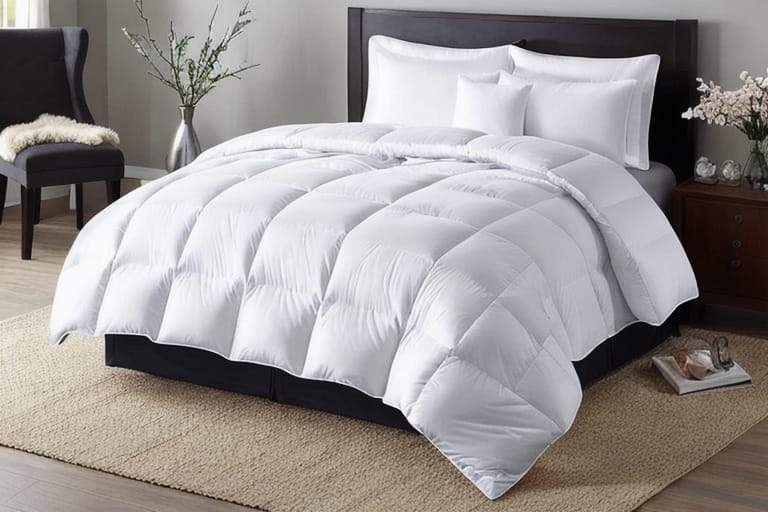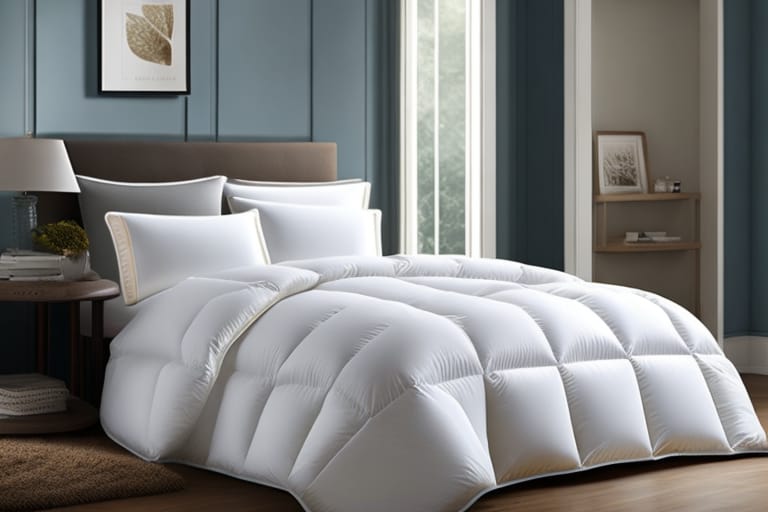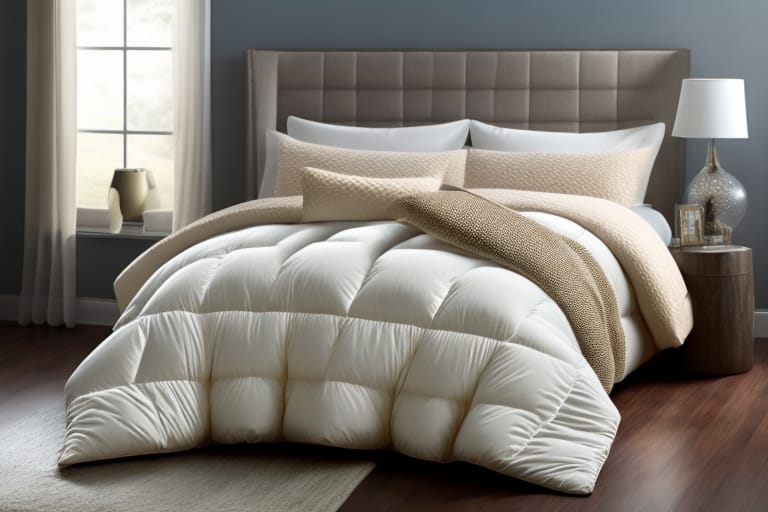When it comes to bedding and blankets that provide superior warmth and softness, goose down comforters reign supreme. But what exactly is a goose down comforter, and what makes it different from other types of bedding? This beginner’s guide will explain everything you need to know about goose down and its role in creating the ultimate comforting, cozy and lightweight blanket.
What is Goose Down?
Goose down refers to the layer of delicate, fluffy feathers and plumules found underneath the exterior feathers of ducks and geese. Waterfowl such as geese have an outer layer of sturdy contour feathers which protect them from wind and water. Underneath this coarse outer plumage layer lies an inner layer of fine, fluffy down feathers that keep the birds warm.
Goose down clusters provide unrivaled insulation capabilities compared to most other materials. The tiny feathers trap air between them to create loft and warmth without adding much weight.
Down clusters from mature geese that live in cold climates tend to be larger and more resilient. Mature down also has superior loft and fill power – we’ll explain what these terms mean shortly.
What is a Goose Down Comforter?
A goose down comforter refers to a type of duvet or quilt filled with this warm and wispy goose down material. The delicate clusters of down are enclosed within a fabric shell to create a lightweight yet exceptionally warm blanket.
The filling in a down comforter is measured in fill power – essentially how many cubic inches one ounce of the down is able to expand to fill when fully lofted. Fill power ranges from about 400 to 900+ – higher numbers indicate better insulation capabilities from a lighter amount of down.
Goose down is superior to lower cost duck down when it comes to fill power, loft and durability. Mature geese produce more sizable and resilient down clusters that will last much longer than duck down.
Benefits and Features
So what makes goose down comforters such a luxurious, best-in-class choice for bedding?
Unparalleled Warmth
The unrivaled insulating properties provided by the three dimensional structure of fluffy goose down makes these comforters the ultimate solution for staying toasty warm. The wispy material traps body heat effectively to maintain a comfortable temperature all night long.
Goose down provides the highest warmth-to-weight ratio of any insulator – it’s the lightweight champion for keeping you cozy on cold winter nights without the burden of a heavy blanket.
Ultra-Plush Softness
In addition to cloud-like warmth, goose down comforters caress you in supreme gentleness. The incredibly soft, silky and fluffy down feathers create a sensation akin to sleeping on a cloud.
The delicate material doesn’t poke or prod, instead gently cushioning your body with an airy yet substantive feel.
Long Lasting Resilience and Durability
The large, mature down clusters that fill a high quality goose down comforter are exceptionally resilient and made to last. These comforters maintain their loft and insulation even after years of regular washing and use.
Over time, the capacity for the down to loft may diminish slightly, but still continues performing far better than lower quality duck down or synthetic alternatives.
Goose down comforters made with high fill power down >600 fp represent a worthwhile investment into a product that should last 15-20+ years with proper care.
Moisture Resistant
The structure of fluffy goose down allows it to regain loft quickly after getting compressed. Even if stored tightly or exposed to some moisture, goose down will quickly rebound when uncompressed.
Synthetic down alternative comforters lose their ability to insulate when compressed or wet. Goose down has the superior ability to bounce back to full loft over and over again.
Ethical Options Available
In the past, some down comforters raised ethical concerns regarding live-plucking of birds and animal cruelty.
Nowadays most quality manufacturers produce cruelty-free down comforters that use only ethically sourced goose down as the filling. The best down is also traceable back to birds that were never force-fed or live-plucked.
Look for certifications like the Responsible Down Standard (RDS) when purchasing a goose down comforter.

How is Goose Down Harvested Ethically?
You may be wondering how goose down comforters get their fluffy filling without harming geese. Responsible manufacturers adhere to strict protocols for ethical harvesting of down.
After the bird is processed for meat, the down is gathered via brushing the feathers – absolutely no live plucking involved. Ethically-produced goose down should come from birds raised for meat.
Pros and Cons of Goose Down
| Pros | Cons |
|---|---|
| Exceptional warmth for the weight | Premium pricing – costs more than alternatives |
| Ultra-plush, cloud-like softness | Needs special care when cleaning |
| Long-lasting durability and resilience | Some people may be allergic to natural down |
| Regain loft even after compression | Vulnerable to getting clumpy in very humid environments |
| Contours to body for comfort | Not a vegan product |
Down Comforter Alternatives
While goose down comforters represent the gold standard for warmth and comfort, they aren’t the only option for bedding:
- Duck down comforters – typically offer lower prices than goose down, but also don’t have the same level of durability, loft or insulation power. Still a decent budget friendly natural down option.
- Down alternative comforters – provide a synthetic fill to mimic properties of natural down, usually at lower price points. But they lose their fluff more quickly and don’t regulate temperature nearly as effectively.
- Wool comforters – made from breathable yet insulating wool for warmth without weight. But doesn’t provide the same sensation of plush softness as down.
- Cotton comforters – lightweight and affordable, but lacks the resilience and insulation power needed for winter warmth. Better suited for warmer climates/seasons.
What About Fill Power?
You may encounter the term “fill power” when comparing goose down comforters. This refers to an important measurement of the loft or fluffiness that the down provides.
Specifically, fill power measures the number of cubic inches one ounce of down feathers will fill when fully expanded. So higher numbers equate to greater lofting power – the ability to trap more air and provide better insulation – from less down material.
Fill power depends not just on the type of bird, but the maturity level and part of the body where the down was harvested from. Mature geese bred in colder regions tend to produce more sizable, advanced down clusters that score higher on the fill power scale.
Here’s what the different ranges typically signify:
- Under 400 – Low quality down and loft
- 400-600 – Decent mid-range fill power
- 600-800 – Good quality goose down, suitable for most climates
- 800+ – Exceptional fill power only found in mature geese down
Popular comforter options like the ones below showcase the superior insulation powers of high fill power goose down:
- Boll & Branch 700 fill power comforter
- Brooklinen 700 fill power comforter
- Parachute 700 fill power comforter
- Feathered Friends 700+ fill power comforter
- Snowe 700 fill power comforter
Paying up for 700+ fill power represents a smart investment to secure a goose down comforter that will last over 20 years with proper care. The exceptional durability and longevity offsets the higher upfront costs over time.
How to Wash a Goose Down Comforter
To help your goose down comforter lifespan achieve max longevity, proper washing techniques are key. Here are helpful care instructions to safely clean your comforter at home:
- Use a front loading washing machine – Agitator machines can damage the baffles holding the down in place
- Gentle wash cycle in cold water with mild detergent
- For best results, use a special down wash like Nikwax Down Wash Direct
- No fabric softener – coats feathers decreasing loft
- Extra rinse cycle to fully remove soap residue
- Gentle tumble dry with a couple clean tennis balls on low heat until fully dried
- Avoid overheating – can damage feather structure
- Every 3 washes refresh loft by drying in the sun
- Dry clean for stubborn stains; avoid commercial machine drying
With the proper routine for washing and drying, your goose down comforter will maintain its magnificent loft and insulation powers for well over a decade.

Enjoy the Warm Embrace of Luxurious Goose Down
Why settle for alternative bedding that can’t match the cloud-like comfort of genuine goose down? When cared for properly, the fluffy fill offers unmatched softness, plushness and featherlight coziness.
The unbeatable combination of warmth and pliance provides a sensory experience far superior to any synthetic alternative. As far as delivering that delightful “sleeping on a cloud” sensation night after night goes, goose down comforters stand alone.
Frequently Asked Questions
What is the benefit of goose down versus duck down?
Goose down provides superior loft, durability and insulation compared to duck down. The more mature down clusters from geese are larger and more resilient, trapping more air to create better warmth without weight. Mature goose down offers higher fill power, keeping its fluff over many years of use.
What thread count is best for a down comforter?
For goose down comforters, a thread count between 300-600 is ideal. Too high over 600 and the fabric becomes dense enough to prevent the feathers from fully expanding. Around 400 thread count with goose down offers the best combination of breathability for the filling and protection.
How do I know if my comforter has enough fill in it?
Check that the comforter has uniform thickness and loft throughout, without flat spots in certain areas. When you fluff the comforter, the down clusters should spring back readily to maintain an even distribution and maximum height. With proper fill power and fill amounts, your goose down comforter will feel substantial with puffy loft to cradle your body gently all over.
What’s the big difference between down and synthetic comforters?
Natural goose down provides matchless softness, breathability and resilience that manmade materials cannot rival. Down alternative comforters lack the tantalizingly plush feel and cloud-like loft of waterfowl down feathers. And over time, synthetics lose their ability to insulate and recover from compression. Goose down bounces back readily even after years of washing and sleeping.
How often should I have a down comforter cleaned?
Every year or two, having your goose down comforter professionally cleaned will restore maximum fluffiness and help extend its lifespan. But for regular upkeep to remove body oils and refresh the floof, home washing 2-4 times a year following the proper gentle care methods is recommended. Avoid overdrying and never have your down comforter commercially machine dried or dry cleaned more than 1-2 times annually.








